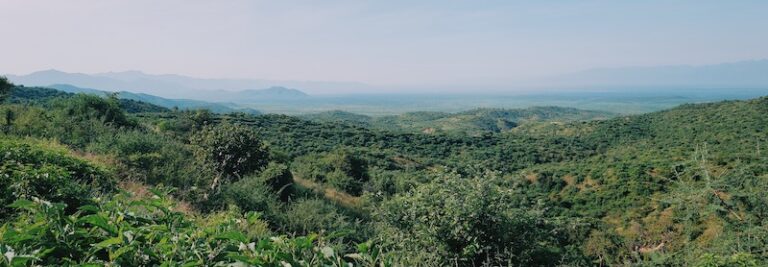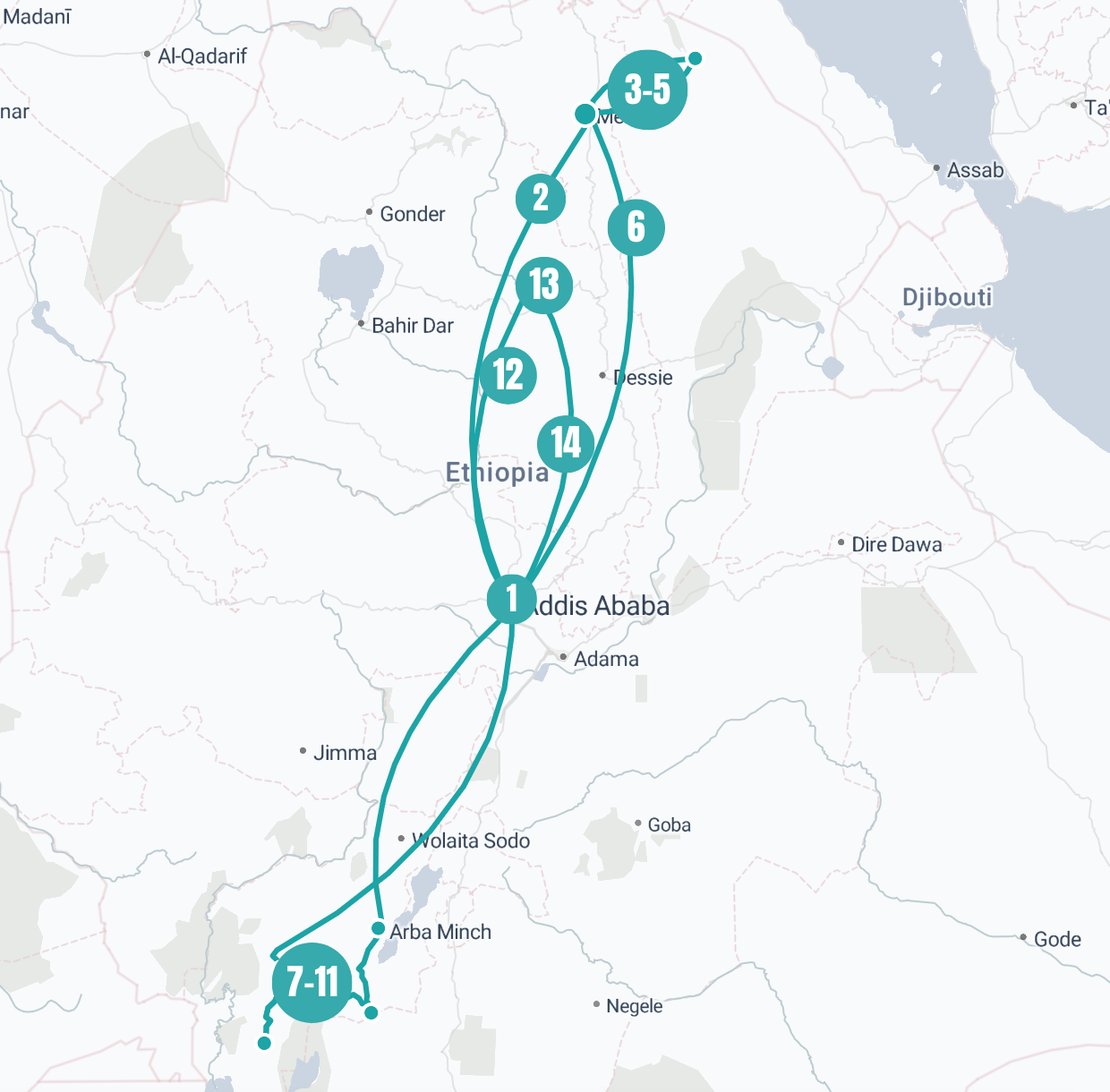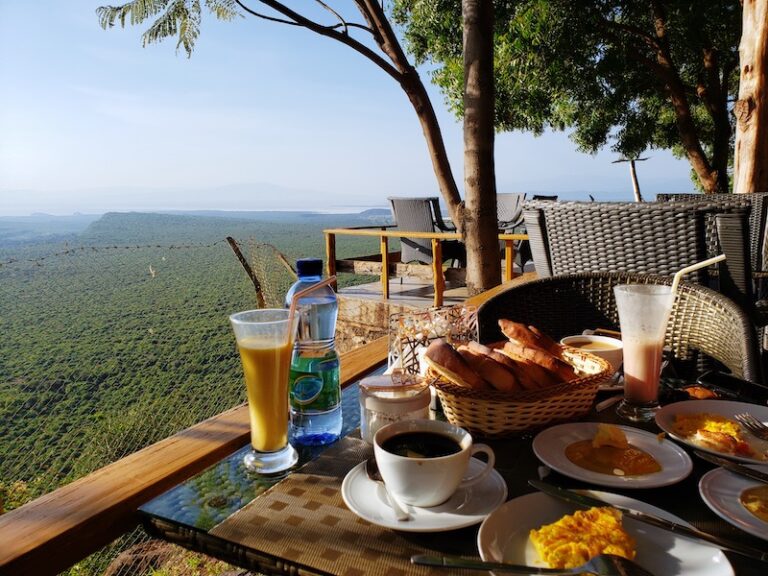Ethiopia
We traveled to Ethiopia right before the Tigray War. It was not an easy trip, but the alien-like landscape in the north, the body-painted tribes in the south, the ancient rock-hewn churches underground, and of course the coffee, the food, the richness of its culture and history free from colonization had totally wowed us. It is probably one of the most underrated countries in the world and one of the last where untapped beauty and originality is still readily accessible.
FULL ITINERARY
- Nature
- Culture
- Landmark
- Organized Tour
- Traveled in December 2019
- Day 1: Arrival in Addis Ababa
- Day 2: Flight to Mek'ele
- Day 3: Danakil Depression 3-Day Tour
- Day 4: Danakil Depression 3-Day Tour
- Day 5: Danakil Depression 3-Day Tour
- Day 6: Flight to Addis Ababa
- Day 7: Omo Valley 5-Day Tour
- Day 8: Omo Valley 5-Day Tour
- Day 9: Omo Valley 5-Day Tour
- Day 10: Omo Valley 5-Day Tour
- Day 11: Omo Valley 5-Day Tour
- Day 12: Flight to Lalibela
- Day 13: Lalibela
- Day 14: Flight to Addis Ababa & Departure
Day 7
OMO Valley 5 day tour
Flight to Jinka to begin the Omo Valley 5-day tour. Visit Mursi tribe | Overnight in Jinka
11:00 am
Flight from Addis Ababa to Jinka

At the southern tip of Ethiopia, where the Omo River delta enters Lake Turkana, is a spectacularly beautiful area co-habited by a mixture of indigenous tribes whom may be one of the last peoples on earth intact from modern civilization. Tourism is booming in this area, thanks to the looks and way of life of these tribes that make you feel like you’ve just stepped into a National Geographic documentary. But tourism also brings controversy – described by some as “human safari”, it’s almost impossible not to construe one’s curiosity as disrespect and even judgment. Modern civilization is closing in. Massive dams have been built on Omo River which devastated the livelihood of these tribes who have relied on the seasonal flooding for centuries. Tribesmen are now learning about phones and money. Some may even want to venture out to the other parts of the world. The last remaining cultures of untouched ancient Africa is sadly disappearing.
Traveling to Omo Valley is expensive and possibly tricky. The language barrier, inaccessibility, and lack of options means you are pretty much at your tour operator’s mercy when you get there. Our tour guide left us with the driver on the second day and we had a big argument with him at the end of the five-day tour over hotel and fees. Fortunately, our driver is a great guy and we were happy with what we’ve seen and experienced these five days. We even made it to the airport on time on the last day despite of a car breakdown hours earlier!
2:00 pm
Lunch
4:00 pm
Mursi Tribe
We requested to visit Mursi first, a small tribe located in Maga National Park known for their lip plates. We made a one time payment with the chief to take their photos freely. The teenage girls were fascinated with my lipstick and my clumsy attempt to join them in their daily chore. A curious young man tried to have a conversation with us. But mostly, the women, with their stern look, dangling lip and sharp teeth, radiated a level of fierceness and strength that is both fearsome and admirable. Making dinner is hard work, considering the process starts from grinding grain into powder by hand. I couldn’t help but noticing while women were doing all the work, no man helped. They sat in a different area talking. Maybe they were in a meeting. It’s also women who get their lips pierced from adolescence for the lip plate as it symbolizes their social maturity and eligibility for marriage.
6:00 pm
Dinner
Day 8
OMO Valley 5 day tour
Drive to Turmi and visit Hamar market and bull jumping ceremony | Overnight in Turmi
8:00 am
Drive from Jinka to Turmi
Turmi is the base to visit several tribes including the populous Hamar people. The drive took about 3 hours.
11:00 am
Hamar Market
The market is a great place for people watching and getting a glimpse of their lives. It’s not a tourist trap, at least not yet, although we did see a few vendors selling souvenirs. We also had lunch there, where a group of hungry kids devoured our leftovers right after we finished. I felt terribly bad. The market day differs for each tribe and location. Here’s the info that our tour guide gave us:
- Monday: Turmi Hamar Market
- Tuesday: Alduba Hamar and Benna Market
- Thursday: Key Afer Benna and Arie Market
- Saturday: Demeka Hamar Market and Jinka Arie Market
1:00 pm
Lunch
2:30 pm
Bull Jumping Ceremony
The highlight of this entire Ethiopia trip was that we’ve had the chance to see the Hamar tribe’s famous Bull Jumping Ceremony. This is a centuries-old rite of passage for boys to become men. The ceremony involves the young man running across the backs of seven to ten bulls four times without falling. If he is successful, he will be initiated into manhood and thus eligible to get married and raise children. It’s a very festive event with lots of drinking and dancing. However, somewhat disturbing is that as part of the ceremony, women and girls would ask to be whipped on their backs by men and seem to truly rejoice over the pain and scars.
7:00 pm
Dinner
Day 9
OMO Valley 5 day tour
Visit Karo and Hammer villages | Overnight in Turmi
10:00 am
Drive from Turmi to visit Karo tribe
With a population of around 1,000-3,000 people, Karo is one of the smallest tribes in the region. Located on the left bank of the Omo River with an open view of the river and , it’s an extraordinarily peaceful village with friendly tribesmen well known for their body paint.
1:00 pm
Lunch
4:00 pm
Hammer Village
We spent more time inside a Hammer village through sunset, sampling homemade food after a friendly woman invited us into their hut. Got into some trouble with our “unauthorized” drone shot when some official came to our hotel and gave us a talking to in the evening. We paid some money. I suspected this was all it was about, but of course we the dumb foreigners would never know.
7:00 pm
Dinner
Day 10
OMO Valley 5 day tour
Visit Konso Village and Lake Chamo | Overnight camping in Arba Minch
9:30 am
Drive from Turmi to Konso Village
A significant upgrade from the scattered huts that we previously visited is the World Heritage Site of the Konso Village. This stoned walled tiny hilltop territory has housed 21 generations over the past 400 years. There is a strict social order as to the location of each family compound – whether it is located in the inner or outer terraces.
4:00 pm
Drive to Arba Minch
7:00 pm
Dinner
Day 11
OMO Valley 5 day tour
Visit Dorze Village and fly from Arba Minch to Addis Ababa | Overnight in Addis Ababa
8:00 am
Breakfast at Arba Minch
Not that we didn’t eat breakfast the other days, but this was the first nice meal we’ve had throughout the entire Omo Valley tour. How we appreciated this indulgence. And what an amazing view! Arba Minch seems to be a well developed city with fairly westernized accommodations. On this last day of our tour, our tour guide Oumer screwed us again by not placing us in the Paradise Hotel he promised and yet still demanding a hefty tip. I spent hours arguing with him. We ended up giving our driver a nice tip who was apparently pleasantly surprised.
10:00 am
Drive to Dorze Village
Located so close to Arba Minch, I can’t blame that the whole routine surrounding our visit to the Dorze Village feels like a performance for tourists. We appreciated the bizarre looking huts and the traditional wardrobe they put on us for photos. But sitting around a table in the backyard with the host family, sharing homemade pancake and liquor over cheers was the most memorable.
12:00 pm
Fly from Arba Minch to Addis Ababa
Of course the car had to break down on the last day of the tour. In fact, it broke down twice, both in and on the way out of the Dorze Village on the hills just outside of Arba Minch. As our flight departs in the early afternoon, I had to hid the little bit of panic I was starting to feel thinking oh boy we may be stuck here with Oumer. But our beloved driver magically found help and raced to the airport. Just in time.
7:00 pm
Dinner
Day 12
Lalibela
Fly from Addis Ababa to Lalibela | Overnight in Lalibela
12:00 pm
Flight from Addis Ababa to Lalibela
High in the Lasta mountains is one of the country’s holiest places, Lalibela. Named after King Lalibela in the 12th century who built the 11 monolithic churches and what was set out to be the New Jerusalem after Muslim conquests halted Christian pilgrimages to the holy land, this small town was and is still today, a centre of pilgrimage for the Ethiopian Orthodox Christians.
Though it’s a wonder of the world that certainly attracts lots of tourists, the place surprisingly does not feel touristy because most travelers are pilgrims. It was easy to choose and book a tour guide for the main activities the next day – the tour of the 11 rock-hewn churches. With a little bit of time left for the day, we went with a couple of locals and utterly enjoyed a laid back hike and amazing view up on the mountains.
7:00 pm
Dinner
Day 13
Lalibela
Visit the UNESCO World Heritage site of rock-hewn churches | Overnight in Lalibela
9:00 am
Visit Lalibela Churches
Visiting the rock-hewn churches amidst the crowds of pilgrims was one of the most unique experiences we’ve had. Although neither of us are religious, we can’t help feeling the passion and devotion of the pilgrims who trekked a long way here, many of whom in bare feet with nothing much more than their white shawl and a walking stick. They camped on grounds outside the churches, washed feet on the street, and stood quietly on top of grounds overlooking the churches and just prayed. No one set out any rules, but with all the people in all walks of life that gathered here and yet bringing in a sense of serenity that is not common with crowds, there’s no other words I can use to describe the feeling but holiness.
Despite its UNESCO World Heritage Site status since the 70s and the apparent efforts by UNESCO to preserve it, our local guide was quite dismayed. The world outside spent all the money to build shelter and such for the structure but they didn’t understand what they’ve done, he said. It was the exposure to the sun that kept the structure stood for centuries. It’s not meant to be “sheltered”. Now, look at the huge cracks!
7:00 pm
Dinner
Day 14
Addis Ababa & Departure
Flight to Addis Ababa and departure
12:00 pm
Flight from Lalibela to Addis Ababa
2:00 pm
Visit Addis Ababa
The last day in Ethiopia was the day we had the most spare time in Addis Ababa. Without much time pressure as our flight back to US was not until midnight, we savored one of our favorites of Ethiopia, the coffee. The most famous of all in Addis Ababa is of course Tomoca Coffee. Aside from its international fame and enterprising export, the coffee shop was underwhelmingly small (and can get quite crowded) with a few high tables where you sip and go. I’m not a coffee aficionado so no good judgment here, but I frankly enjoyed more the home brewed coffee that we’ve had on the road.


